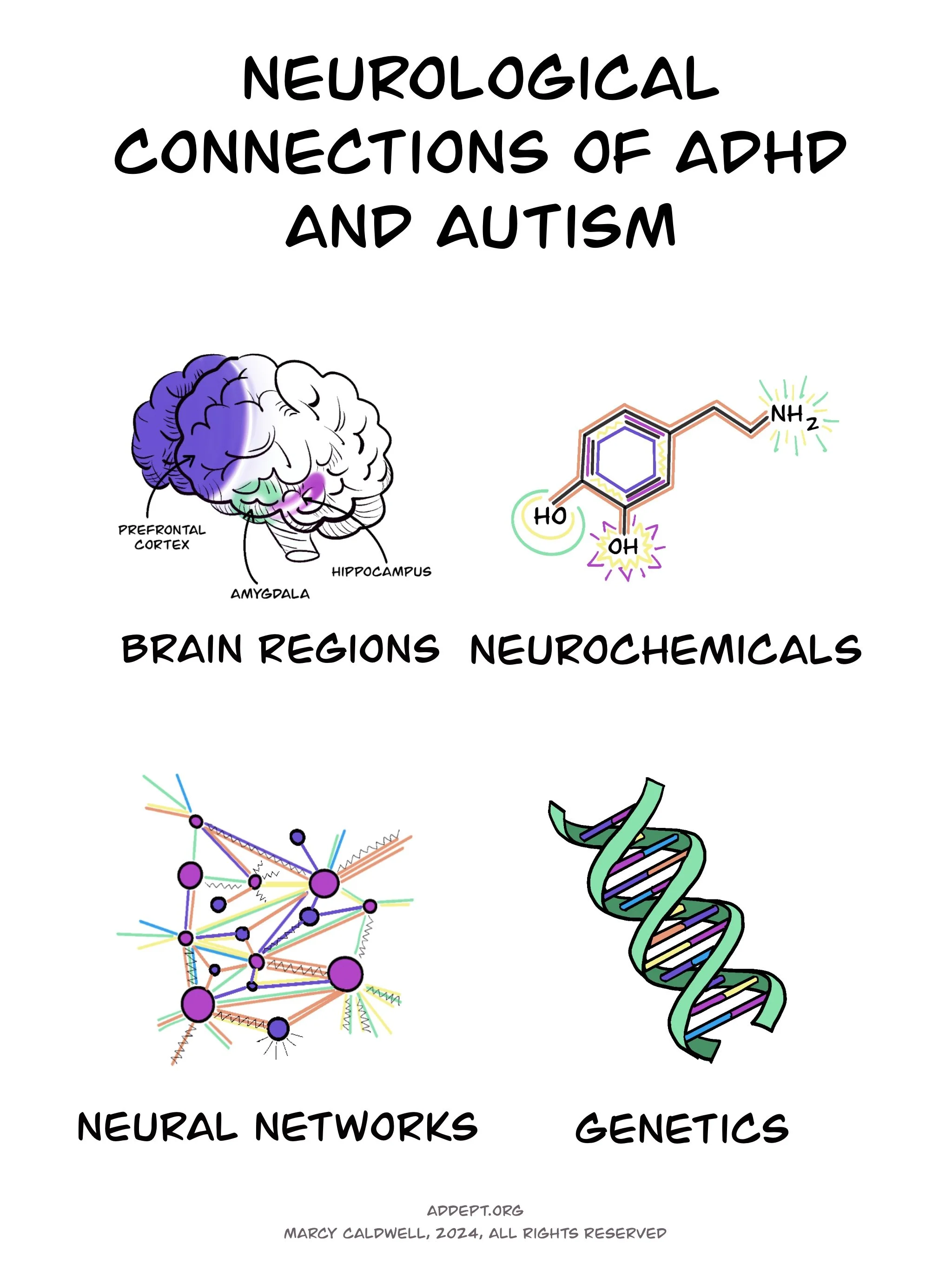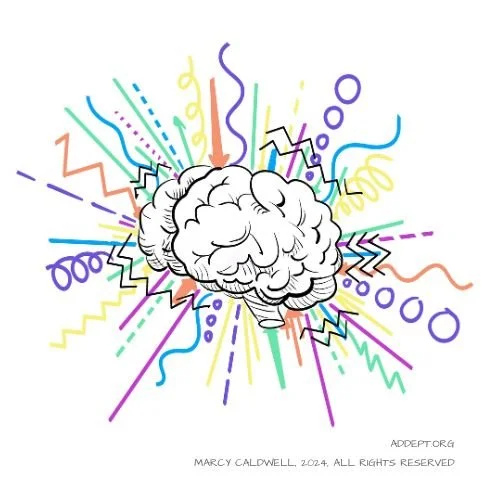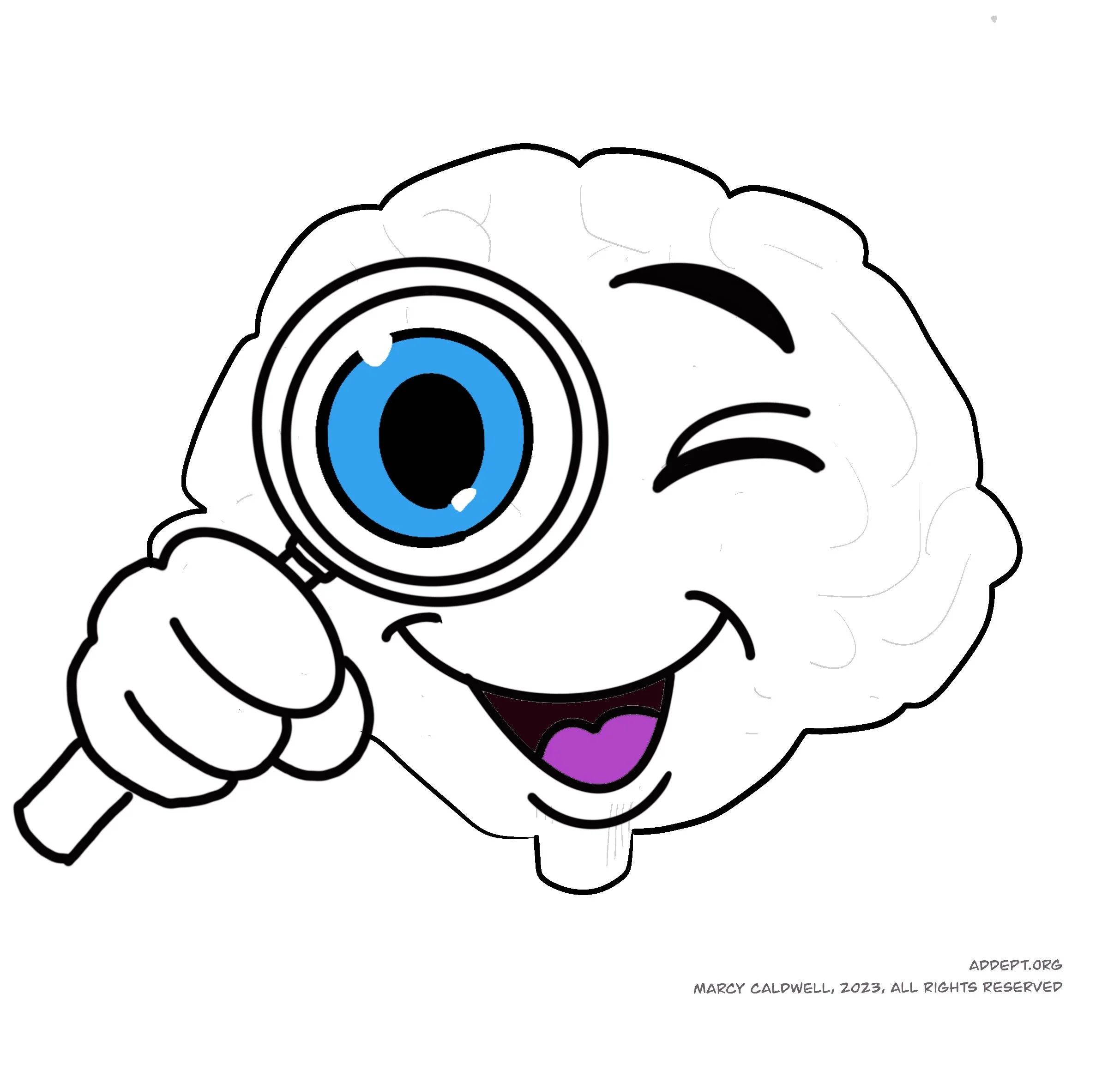Autism or ADHD?
Get Clarity with These 8 Essential Differences
While ADHD and Autism Spectrum Disorder (ASD) are distinct conditions, they often co-occur and share some overlapping symptoms, such as sensory sensitivity, social difficulties, emotional regulation challenges, and hyperfixation, making diagnosis difficult. However, there are also key differences, such as novelty seeking (ADHD) vs. arousal regulation (ASD) and the nature of repetitive behaviors. Getting a specialized and accurate diagnosis is crucial in order to properly differentiate between these two often confusingly similar neurotypes in order to get the best treatment and support.
Explore the distinct strengths, challenges, and unexpected connections between these often overlapping neurodiversities.
ADHD and autism: a dynamic duo? Two sides of the same coin? Or totally separate differences?
The stereotypes of these two neurotypes are completely different: kids with ADHD bouncing off the wall vs. quiet, introspective individuals with autism. But the reality of how ADHD and Autism show up in the real world is much more complex, nuanced, and ultimately confusing! [1]
Because ADHD and autism, while distinct, share some surprising similarities, creating a bit of a "who's who" of neurotypes!
Think of it like this: both ADHD and autism are threads in the beautiful tapestry of neurodiversity. Sometimes, these threads intertwine, making diagnosis a bit of a puzzle. But, once you identify the specific threads, you can create a masterpiece of strategies for success and well-being.
So, let's explore this fascinating overlap between ADHD and autism. Get ready for an enlightening adventure that celebrates the unique strengths and challenges of each neurotype!
Can you have both ADHD and Autism?
Yes! For sure! And many do.
ADHD and autism are two distinct neurodevelopmental conditions, but they very often co-occur. In fact, research suggests that 50-70% of people with Autism Spectrum Disorder (ASD) also have ADHD. [3] And ⅓ of people with ADHD have an Autism Spectrum disorder as well. [4]
The overlap is so common and well-documented, in fact, that the DSM-V (the dictionary of all things psychological/neurological) has a special coding for the co-occurrence of the two [5]
Why are autism and ADHD often mistaken for one another?
ADHD and Autism don’t just often show up together; they often masquerade as each other as well because they share several overlapping symptoms [2]. It's like they're constantly playing dress-up, making it tricky to tell them apart, even for seasoned experts and even when we look at the brain itself.
But why all the confusion? Here's the scoop:
Brain Buddies: Unraveling the Neurological Connections Between ADHD and Autism
It turns out that all this confusion isn’t just on the outside; they share a bunch of similar traits in the brain's inner workings, as well.
Shared Spaces:
Neuroimaging studies have revealed that ADHD and Autism are in the same neighborhoods of the brain’s landscape. They’ve found that they both affect similar areas of the brain, particularly those responsible for social interaction and attention. [6]
Chemical Connections:
But it doesn't stop there. These two conditions also have a knack for messing with the same brain chemicals, like dopamine and norepinephrine. These chemical messengers are crucial for regulating attention, motivation, and impulse control, which explains why ADHD and Autism often share challenges and differences in these areas.
Different Connections:
The brain is a complex network of interconnected regions like a bustling city with various neighborhoods communicating through a network of roads and highways.
In both ADHD and Autism, these neural "roadways" are wired a bit differently. Research suggests that the communication and coordination between different brain regions are different. And just like when construction detours our usual traffic flows, all these different traffic patterns create a whole host of challenges and differences.
Genetic Blueprint:
But where do these wiring, connection, and chemical differences come from?
Turns out genetics play a significant role.
ADHD and Autism share some common genetic factors, like blueprints that contain similar instructions for building the brain's intricate circuitry. These shared genes may influence the development and function of neural pathways involved in attention, social interaction, and sensory processing, contributing to the overlapping symptoms and challenges observed in both conditions.
What are the similarities between autism and ADHD?
For those of us without an MRI machine in our back pocket, how the overlaps of these neurodiversities play out in real life is a whole lot more important. So let’s explore the everyday life similarities:
1. Sensory sensitivity
ADHD and autism can be a symphony of heightened senses. Both nuerotypes often experience the world as a kaleidoscope of intensified sounds, textures, and tastes. You know the deal: certain fabrics are unbearable, and the neighbor's dog’s bark is excruciating. This shared sensitivity is one of the primary overlaps that can blur the lines between the two, making them challenging to unravel.
2. Justice sensitivity
A keen sense of justice and fairness is a terrific quality (though not an altogether easy one)—and it’s also another overlap between ADHD and autism. Getting fixated on or feeling strongly about righting wrongs or ensuring fair treatment is often one of the common traits that can indicate that one or both of these two might be in the mix.
3. Rejection sensitivity
Both autism and ADHD can involve intense emotional responses to perceived rejection or criticism. Everyday events like an unanswered text message can trigger a cascade of emotional distress that can leave others scratching their heads.
4. Inflexibility
Forget the stereotype of ADHD as a whirlwind of spontaneity. Sure, sometimes that’s the case, but like so many things ADHD, the other extreme is equally true. In fact, both ADHD and autism share a tendency towards rigid thinking and resistance to change. Whether it's clinging to routines or struggling with transitions, this inflexibility is one of the key factors that distinguishes both ADHD and ASD.
5. Social difficulties
Social interactions can feel like navigating a labyrinth when you have an ADHD or Autistic Brain. Misinterpreting social cues or struggling to maintain conversations can spark social anxiety and uncertainty, making simple interactions feel like a high-stakes game.
6. Hyperfixation
Both ADHD and autism can unlock the power (and vulnerability) of hyperfocus, an intense concentration that makes the world melt away as we become immersed in our passions. While this can be a source of incredible creativity and productivity, it can also lead to neglecting essential responsibilities and basic needs.
7. Emotional regulation difficulties
Emotional regulation can be a wild ride for ADHD and autistic brains. Mood swings, frustration, and emotional outbursts can erupt in response to stressful or unexpected situations, leaving individuals and those around them feeling like they're on an emotional rollercoaster.
The 9 Key Differences between Autism and ADHD
Okay. So it’s clear ADHD and autism have a lot more in common than many people think- both inside the brain and outside in the world, the overlap is strong and consistent. But there are also key differences that are crucial to understanding in order to make sure we are getting an accurate and fully informed diagnosis.
1. Genetic subtype
While there is genetic overlap between ADHD and ASD for sure, Research shows that ADHD and autism have different genetic subtypes. This suggests that, despite some overlapping symptoms, these are ultimately different conditions [8].
2. Novelty seeking
Crave new experiences? That’s a check in the ADHD column, then. ADHD is often associated with higher ‘novelty-seeking’ behavior. This means that the dopamine-hungry ADHD brain often goes off in search of new and dopamine-stimulating stimuli (and means they get bored a whole lot more easily) [7].
3. Arousal regulation
ADHD and Autistic brains also tend to regulate their arousal levels differently. And while there is some overlap on this one, the general tendency is often that:
The ADHD brain yearns for stimulation, like a car idling in neutral, craving the open road. Without this type of stimulation, it’s left with hypo-arousal (under-arousal)that can leave it feeling sluggish, inattentive, and perpetually seeking sensory fuel to ignite its engines. [8]
In stark contrast, autism is more often hyper-aroused, meaning the senses are dialed up to eleven, making even the faintest scent or change in routine overwhelming. This sensory overload can lead to meltdowns, anxiety, and a desperate need for a quiet, calming refuge.
4. Cortical variances
Autism and ADHD leave distinct marks on brain structure as well. Autistic brains show thicker brain matter in specific areas, while ADHD brains have more widespread but less pronounced differences. To add to this differentiation, sex influences brain structure in autism, but not ADHD. [9]
5. OCD and ADHD
People who have both OCD and ADHD also have higher autism scores than those who don’t show obsessive or compulsive behaviors. [10]
6. Social challenges
ADHD and autism can lead to social challenges, such as difficulty reading social cues. But these difficulties come in slightly different flavors. For instance, ADHD might cause more impulsive social behavior (including getting distracted during conversations, interrupting, or changing the subject), while people with autism might seem more withdrawn or have repetitive social interactions. [11]
7. Focus and attention
One challenge of ADHD is that it can be tough to focus on ‘boring’ tasks— yet in other cases, people can hyper-focus on topics or activities that they find fascinating. Autism, on the other hand, is characterized more by having intense, narrow interests and the ability to concentrate deeply on specific topics or activities for long periods (Ridderinkohf, 2020).
8. Repetitive behaviors
Repetitive behaviors, such as ‘stimming’ (for instance, hand flapping) or an insistence on sameness, are a core characteristic of autism. Yet this isn’t seen in ADHD, where people might repeat behaviors due to impulsivity, but not in the same way.
9. Developmental timeline
Autism symptoms usually appear before age three and can be noticed in early developmental milestones. In contrast, ADHD symptoms might not show up until a person reaches school age. This is because the need to pay attention and self-regulate becomes more important once individuals find themselves sitting behind a school desk.
ADHD or autism? The right diagnosis is crucial.
On the surface, distinguishing between ADHD and autism can be as tricky as telling identical twins apart in matching outfits. Both conditions share quirks like sensory sensitivity, social hiccups, and emotional rollercoasters, making the diagnostic process feel like a detective game.
That’s why an accurate diagnosis is crucial. Think of it as finding the perfect pair of glasses; suddenly, everything comes into sharp focus. Whether you have ADHD, autism, both, or even neither (there are many other conditions commonly mistaken for ADHD), getting clear answers can shape not just our understanding of ourselves but also the strategies we use to manage it all.
How to Get an Accurate Diagnosis
Cracking the Code: How to Get an Accurate Diagnosis once and for all
So, an accurate diagnosis is key, but how exactly are we supposed to find that all-mighty cipher?
Well, the good news is you don’t have to do it alone. An expert ADHD/autism specialist can offer you a specialized assessment that can give you the keys you’re looking for.
Why a Specialist is Your Secret Weapon
Imagine trying to uncork your champagne with a hammer. It might work-ish, but a corkscrew’s going to be a whole lot more precise and effective.
An ADHD/Autism specialist is your diagnostic corkscrew, expertly trained to tell the difference between these conditions, even when they like to play dress-up.
But here's the extra important part:
Not only should your specialist be a diagnosis master, but they should also be a pro at understanding how ADHD and autism can show up differently depending on who you are. Gender, age, race, and even sexuality can all influence how these conditions present themselves.
Introducing Your Diagnosis Dream Team!
Look no further than The Center for ADHD (sure- I’m a bit biased, but it’s still true!). Our assessment ninjas (read: psychologists) are rockstars at untangling the web of symptoms and figuring out exactly what's going on. Plus, they have experience working with all kinds of amazing people, just like you!
Ready to Learn More?
Want to dive deeper into the wonderful world of getting tested? Check out this post, How to Get Tested for ADHD and Autism, for all the info you need.
Join the Conversation:
Have you navigated the tricky overlap between autism and ADHD? What was your experience? What tips do you have for your fellow ADDepters?
-
Leitner Y. The co-occurrence of autism and attention deficit hyperactivity disorder in children - what do we know? Front Hum Neurosci. 2014 Apr 29;8:268. doi: 10.3389/fnhum.2014.00268. PMID: 24808851; PMCID: PMC4010758.
Panagiotidi M, Overton PG, Stafford T. Co-Occurrence of ASD and ADHD Traits in an Adult Population. J Atten Disord. 2019 Oct;23(12):1407-1415. doi: 10.1177/1087054717720720. Epub 2017 Aug 11. PMID: 28800716.
Hours, C., Recasens, C., & Baleyte, J. (2022). Asd and adhd comorbidity: what are we talking about?. Frontiers in Psychiatry, 13. https://doi.org/10.3389/fpsyt.2022.837424
Nijmeijer, J. S., Arias-Vásquez, A., Rommelse, N., Altink, M. E., Anney, R., Asherson, P., … & Hoekstra, P. J. (2010). Identifying loci for the overlap between attention-deficit/hyperactivity disorder and autism spectrum disorder using a genome-wide qtl linkage approach. Journal of the American Academy of Child &Amp; Adolescent Psychiatry, 49(7), 675-685. https://doi.org/10.1097/00004583-201007000-00008
Victory, J. and Sunitha, K. (2019). Co-occurrence of attention deficit hyperactivity disorder in children with autism spectrum disorder- a hospital based study. National Journal of Research in Community Medicine, 8(2), 171. https://doi.org/10.26727/njrcm.2019.8.2.171-175
Willis, M., & Robertson, J. et al. (2023). Exploring the shared neurobiology of ADHD and Autism: A systematic review and meta-analysis. medRxiv. https://doi.org/10.1101/2023.12.06.23299587
Lichtenstein P, Carlström E, Råstam M, Gillberg C, Anckarsäter H. The genetics of autism spectrum disorders and related neuropsychiatric disorders in childhood. Am J Psychiatry. 2010 Nov;167(11):1357-63. doi: 10.1176/appi.ajp.2010.10020223. Epub 2010 Aug 4. PMID: 20686188.
Bellato A, Arora I, Kochhar P, Ropar D, Hollis C, Groom MJ. Heart Rate Variability in Children and Adolescents with Autism, ADHD and Co-occurring Autism and ADHD, During Passive and Active Experimental Conditions. J Autism Dev Disord. 2022 Nov;52(11):4679-4691. doi: 10.1007/s10803-021-05244-w. Epub 2021 Oct 30. PMID: 34716841; PMCID: PMC9556357.
Saashi A., Bedford, et. al. (2023) Brain-charting autism and attention deficit hyperactivity disorder reveals distinct and overlapping neurobiology. medRxiv https://doi.org/10.1101/2023.12.06.23299587
Anholt GE, Cath DC, van Oppen P, Eikelenboom M, Smit JH, van Megen H, van Balkom AJ. Autism and ADHD symptoms in patients with OCD: are they associated with specific OC symptom dimensions or OC symptom severity? J Autism Dev Disord. 2010 May;40(5):580-9. doi: 10.1007/s10803-009-0922-1. PMID: 20039111; PMCID: PMC2855859.
McVey AJ, Schiltz HK, Haendel AD, Dolan BK, Willar KS, Pleiss SS, Karst JS, Carlson M, Krueger W, Murphy CC, Casnar CL, Yund B, Van Hecke AV. Social difficulties in youth with autism with and without anxiety and ADHD symptoms. Autism Res. 2018 Dec;11(12):1679-1689. doi: 10.1002/aur.2039. Epub 2018 Nov 26. PMID: 30475451; PMCID: PMC6311999.
Ready to shift from
meltdown to mastery?
This online course has been designed specifically to help teach the strategies ADHD brains need to help them move from overwhelm and meltdowns to confident emotional mastery.
Want to know more about
thriving with ADHD?
Check out these other articles:

















ADHD or Not? The Top 9 Conditions Commonly Mistaken for ADHD